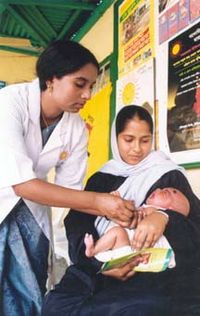
Photo from wikipedia
While prepregnancy obesity increases risk of stillbirth, few studies have evaluated the role of newly developed obesity independent of long-standing obesity. Additionally, researchers have relied almost exclusively on parametric models,… Click to show full abstract
While prepregnancy obesity increases risk of stillbirth, few studies have evaluated the role of newly developed obesity independent of long-standing obesity. Additionally, researchers have relied almost exclusively on parametric models, which require correct specification of an unknown function for consistent estimation. We estimated the association between incident obesity and stillbirth in a cohort constructed from linked birth and death records in Pennsylvania (2003-2013). Incident obesity was defined as body mass index (weight (kg)/height (m)2) greater than or equal to 30. We used parametric G-computation, semiparametric inverse-probability weighting, and parametric/nonparametric targeted minimum loss-based estimation (TMLE) to estimate the association between incident prepregnancy obesity and stillbirth. Compared with pregnancies from women who stayed nonobese, women who became obese prior to their next pregnancy were estimated to have 2.0 (95% confidence interval (CI): 0.5, 3.5) more stillbirths per 1,000 pregnancies using parametric G-computation. However, despite well-behaved stabilized inverse probability weights, risk differences estimated from inverse-probability weighting, nonparametric TMLE, and parametric TMLE represented 6.9 (95% CI: 3.7, 10.0), 0.4 (95% CI: 0.1, 0.7), and 2.9 (95% CI: 1.5, 4.2) excess stillbirths per 1,000 pregnancies, respectively. These results, particularly those derived from nonparametric TMLE, were highly sensitive to covariates included in the propensity score models. Our results suggest that caution is warranted when using nonparametric estimators to quantify exposure effects.
Journal Title: American journal of epidemiology
Year Published: 2019
Link to full text (if available)
Share on Social Media: Sign Up to like & get
recommendations!